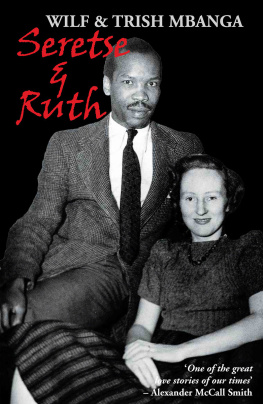CASS LIBRARY OF AFRICAN STUDIES
MISSIONARY RESEARCHES AND TRAVELS
No. 7
General Editor: ROBERT I. ROTBERG
Associate Professor, Department of Political Science, Massachusetts Institute of Technology
TWENTY YEARS
IN
KHAMAS COUNTRY
MISSIONARY RESEARCHES AND TRAVELS
No. 8. Alfred J. Swann
Fighting the Slave Hunters in Central Africa (1910)
With a new introduction by Professor Norman Bennett
Second Edition
No. 9. James Johnston
Reality Versus Romance in South Central Africa (1893)
With a new introduction by Professor James Hooker
Second Edition
No. 10. Frederick Stanley Arnot
Garenganze (c.1886)
With a new introduction by Professor Robert I. Rotberg
New Edition
No. 11. Hope Masterman Waddell
Twenty-Nine Years in the West Indies and Central Africa (1863)
With a new introduction by G.I. Jones
Second Edition
No. 12. W. A. Elmslie
Among the Wild Ngoni (1899)
With a.new introductory note by Ian Nance
New Impression
No. 13. Robert Pickering Ashe
Two Kings of Uganda (1889)
With a new introduction by Professor John Rowe
Second Edition
No. 14. A. M. Mackay
A. M. Mackay, Pioneer Missionary of the Church Missionary Society to Uganda (1890)
By his sister (J. W. H.) With a new introductory note by Professor D. A. Low
New Impression
No. 15. James Frederick Schn and Samuel Crowther
Journals of the Rev. James Frederick Schn and Mr. Samuel Crowther, who, with her Majestys Government, accompanied the Expedition of the Niger in 1841, on behalf of the Church Missionary Society (1842)
With a new introduction by Professor J. F. A. Ajayi
Second Edition
Published by
FRANK CASS AND COMPANY LIMITED
This edition published by Routledge - 2012
2 Park Square, Milton Park, Abingdon, Oxon, OX14 4RN
711 Third Avenue, New York, NY 10017
Routledge is an imprint of the Taylor & Francis Group, an informa business
| First edition | 1895 |
| Second edition | 1895 |
| Third edition | 1970 |
Transferred to Digital Printing 2006
New introduction 1970
ISBN: 978-0-714-61870-8 (hbk)
ISBN: 978-1-136-25624-0 (ebk)
General Editors Preface
In an uncharacteristic understatement, the missionary Frederick Stanley Arnot wrote in 1882 that Mr. Hepburn, the resident missionary in Shoshong, Bechuanaland, had brought much spiritual blessing to the Ngwato people of whom Kama was then chief. Building upon the strong foundations laid by the Rev. John Mackenzie, Hepburn extended the influence of the London Missionary Society into every corner of Khamas country. The native converts, wrote Arnot, have carried the Gospel to village and tribe far and near. For twenty years Hepburn laboured assiduously and successfully in this region; the present book, which went through two printings when it was first published, is a faithful record of those lonely but rewarding years among a people who had grown to revere the message of the Gospel.
Although the following text is set in a low key, it contains much of interest to the historian of southern Africa. Hepburn had fewer imperial pretensions than many of his predecessors and contemporaries, but Khama was a critically important figure and the following record must be read with that context in mind.
Dr. Cecil Northcott, now the editorial secretary of the United Society for Christian Literature and senior editor of the Lutterworth Press, has provided a biographical sketch of Hepburn and a short note on his work among the Ngwato. Dr. Northcott was for fifteen years home director and literary superintendent of the London Missionary Society. He is a Master of Arts of the University of Cambridge and a Doctor of Philosophy of the University of London. He has written the standard biography of Robert Moffat Robert Moffat, Pioneer in Africa (London, 1961)a popular history of the London Missionary Society, Livingstone in Africa (1957) and Christianity in Africa (London 1965).
R.I.R.
22 December 1967
Introduction to the Third Edition
J AMES DAVIDSON HEPBURN (18401893) served the London Missionary Society among the Bamangwato in Bechuanaland (since 1966 the Republic of Botswana) from 1870 to 1893, and his book is a collection of the letters he wrote to the London headquarters of the Society during that time, with chapters one and twelve written by Mrs. Hepburn, and the whole edited by his friend C. H. Lyall. While not of the same quality as Robert Moffats Missionary Labours (1843), David Livingstones Missionary Travels (1857) or John Mackenzies Ten Years North of the Orange River (1871) Hepburns book is nevertheless a genuine contribution to the historical literature of southern Africa and particularly to the history of the Sechuana speaking peoples and their contacts with Europeans and Christian missionaries.
Hepburn was typical of the young men who were recruited in the nineteenth century for missionary service in southern Africa. Born in Newcastle-on-Tyne, he had little formal schooling and was early sent to work for his uncle, a flour miller. At the age of 23 he experienced conversion at a revival meeting, and was led, through his reading of missionary magazines, to offer his services to the London Missionary Society. He was sent to the theological academy at Rotherham and later to a similar one at Highgate. Biblical study in a thoroughly orthodox evangelical atmosphere deepened the simple, dedicated piety that shines through his letters.
Although like all his colleagues in the Bechuana mission he had had no training in anthropology, or in the ways of ethnography, Hepburn was able to count on the practice and prestige which had been laboriously acquired by his colleagues in the mission. Robert Moffat (1795-1883) had only just retired from his fifty years of work in Bechuanaland and the fame of the old pioneer was a living asset among all the peoples from the Limpopo to the Zambesi. John Mackenzie (1835-1899), one of the ablest missionaries ever sent to southern Africa, had just completed a decade of work among the Bamangwato and had himself introduced Hepburn to them. Southwards among the Bakwena at Molepolole was Roger Price (1834-1900) with his twelve years of experience among the Bechuana.
By the time that Hepburn arrived at Shoshong in 1871, the tribal pattern of the Bechuana had become fairly stable since the threats of Ndebele (Matabele) raids had been removed following the death of Mzilikazi (Moselekatse) in 1868 and the absence of further eruptions of tribes from the south. But the internal affairs of the Bamangwato were far from stable, and the account of it which Mrs. Hepburn provides in chapter one is over simplified. The Bamangwato were facing two disruptive factorsthe internal struggle for the succession to the chieftainship, and the demands of the Christian ethic on their corporate life as a tribe.
The struggle for the chieftainship went back to the almost mythical days of the great chief Khari and his sons Sekhomi and Macheng. Sekhomi was undoubtedly the son of a secondary wife while Macheng was the son of the principal wife and therefore the true heir of Khari, but as a child of nine or ten, when in the guardianship of Chief Sechele of the neighbouring Bakwena, Macheng was carried off into captivity by a marauding gang of the Ndebele, and for twenty years was brought up as a Ndebele soldier.1









